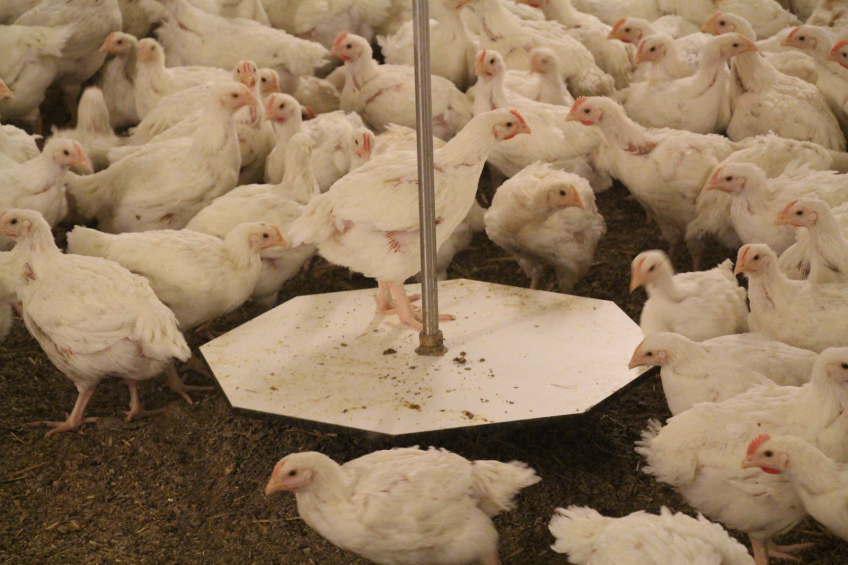Re-learning how to grow broilers

Worldwide slow-growing broilers are gaining ground. However, it’s still an art to adapt one’s management style when for decades the focus has been on maximum growth.
In several European countries farmers are changing to slow growing birds. Following this trend other countries around the world are now turning towards producing slow growing broilers as well. The experiences of various broiler farmers show that managing slow growing broilers is an art in itself, especially if one has always been focusing on maximum growth rate. One has to believe in it; otherwise it is better not to make this change.
First-hand experience comes from Kees Rijkers from Veldhoven in the Netherlands. The last four broilers flocks of Rijkers have been produced according to the Good Nest Chicken (GNK) concept of Plukon Food Group. This means a maximum average daily gain (ADG) of 50 g/d for which he uses the slower growing broilers of Hubbard, the Hubbard JA987. In total Rijkers now has grown eight cycles of this type of broilers. Both the broiler farmer and his technical advisor of Hubbard, Henri Bel, very clearly see that this slower growing broiler has other needs than conventional broilers. Rijkers: “Already in the first cycle we gave the broilers feed with a different composition. The percentage of amino acids (proteins) was initially reduced by 3.5%. That proved not to be enough, so from the third cycle onwards the amount of proteins was reduced by 6% compared to conventional broiler feed.” According to Rijkers and Bel it’s very important to have a close cooperation between feed supplier, hatchery, primary breeding company and the customer to ensure that these broilers will be delivered according to the concept. Rijkers: “By constantly consulting one can adjust the management when needed.”
Managing growth
According to Bel slow growing broilers not only need less protein, they also need less energy (cereals/fats). Starting from the first cycle the energy content in the feed was reduced by 3%. Starting from the 5th cycle the percentage of energy stayed the same in the starter feed, but the energy level in the grower and finisher feed was reduced again by 3%. Rijkers really needed to get used to it, especially the first flocks. “I really had to realign my focus from being only fast growth orientated to growing according to the concept conditions. This meant getting away from my focus on looking at the standard Dutch system of ‘corrected feed conversion at 1500 grams’ (FCR1500) and instead of that to work with the actual FCR. Despite a lower percentage of amino acids and energy in the feed initially they still grew a little bit too fast.”
The rules of the GNK-concept include a maximum stocking density of 38 kg/m2 and a maximum ADG of 50 g/d. To achieve the best results, the structure of the feed is also different. Another adaptation to the feed is that the first seven days the feed contains less hard or big pellets than before. During the whole cycle the feed is presented as crumb instead of pellet. Rijkers: “It’s also important that there is an optimal access to the feeders, especially in the first weeks. I use very open pan feeders of Bokalan. The chicks can easily find and use these pan feeders, I’m very satisfied about that.”

Not too much feed at once
At the time that the first slow growing broilers were placed in the Dutch market the breeder flocks were still at a young age. Rijkers got relatively smaller chicks. In that case it’s even more important to assure that they have easy access to feed and water to give them the best start. “I also had to get used to the fact that this type of broiler is a more social bird. So when they huddle together it doesn’t always mean that they’re cold, but it may be that they do that just as a social behaviour.” Because they are more active and have a better feathering, the level of heating can be lower than with conventional broilers. Rijkers: “The art is to make sure they always have access to fresh feed. Not all the pan feeders should be full, but from 14 days onwards only a covering at the bottom of the pan, which also avoids the risk of wastage and selective eating.”
Rijkers works with ProCare chicks which have had access to water and feed in the hatchers right after hatching. This pleases the broiler farmer very much. “With this slow growing broiler the need for water, immediately after placement, is less,” said Bel. “Not only because they eat less per day, also the water/feed-ratio is lower, now some 1.6 versus 1.8 of conventional broilers.” On every 15,000 broilers Rijkers uses three feeding and four water lines.
| PROFILE: Partnership Rijkers, Kees (53), Marion (50) and Bart Rijkers (24), Veldhoven, the Netherlands. |
Manure control
What is also different about the management in comparison to conventional broilers is that right from day one the chicks get a rest period of four hours. From day seven this is six hours and when they’re growing sufficiently eight hours. Each cycle the broilers stay about seven days longer than conventional broilers, so about 49 days instead of about 42 days. Harvesting is possible according to the concept, but Rijkers makes no use of it. He prefers an all-in all-out system because it is safer in terms of disease risk. The last 8 flocks the mortality rate was on average 1.36%.
The Dutch broiler farmer has, as long as he produces slow growing broilers, not used any antibiotics. He notes that the broilers are clearly more robust. Concerning the water management, the same procedure is followed as with conventional broilers; make sure that the water pipes are always clean. He recommends a water pressure that’s not too high. “Certainly with this slow growing broiler this is important. Otherwise they drink and eat more.” In each of his five houses he has a manure control unit. A few times a day he checks the quality of the manure in it. “Quite logical, when the digestion is good, the manure quality is also good. The cecum faeces should look like a hearty pile of caramel custard, so to speak.” In April 2015 the chicks from the first flock of the GNK-concept were slaughtered. It showed you have to weigh the broilers at least weekly to adjust your management on time.













